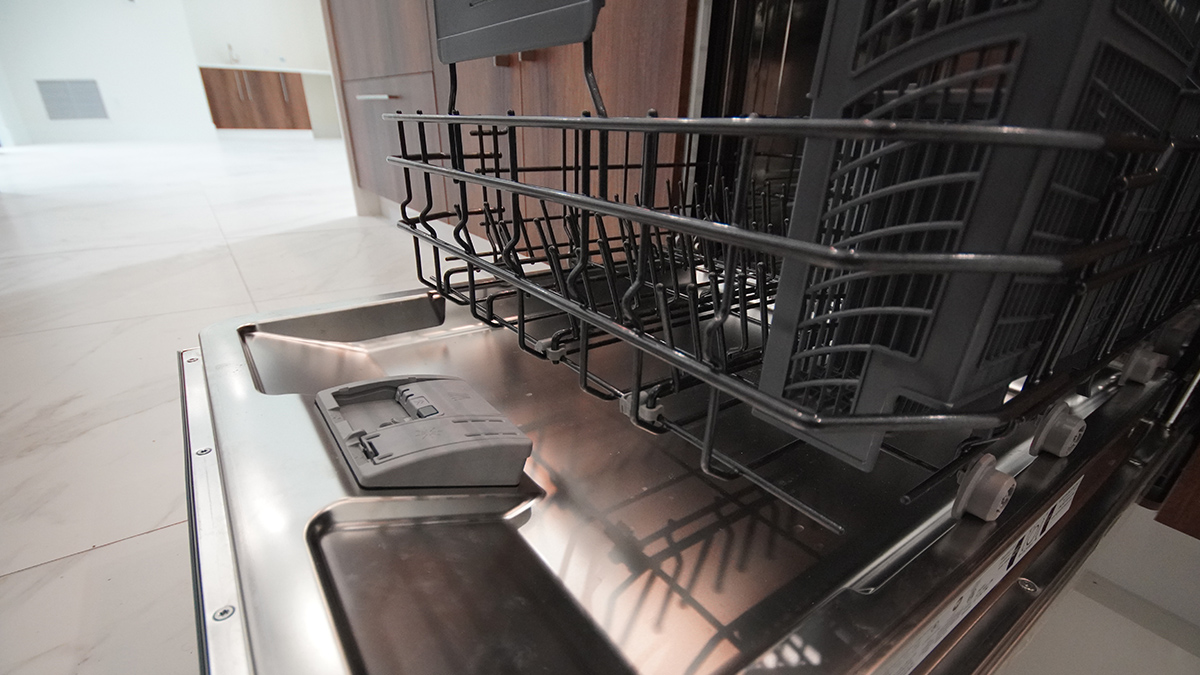What Is Your Dishwasher Hiding?
Dishwashers can leak! And leaks can cause water damage. They can be a drip – drip – drip or more Niagara Falls, and anything in between. None of them is good but all deserve immediate attention. What starts as a drip could evolve into your own personal waterfall. It won’t attract tourists, so you can forget setting up a gift shop. If you can’t profit off a gift shop, you’re better off resolving the drip and avoid the worse headaches that come with the waterfall variety of leak.
In another article, we discuss problems with leaks in the door. Those of both drip – drip – drip and the waterfall variety. Here we’ll discuss the more sinister side of water. The hidden leaks that cause trouble in the dark. And this is only one of the ways you can find water damage in your kitchen.
Hidden Leaks Underneath the Dishwasher
You want your dishwasher to wash your dishes, but not the floor. Bad seals or gaskets underneath the dishwasher in the motor assembly, the sump pump, or water connections can all torture your floor to the point where it will tell you anything you want to hear. The problem with these drips is that you probably won’t see them happening, and that isn’t cleaning anything anyway. They’ll be underneath the washer and can cause water to pool. As it settles on the floor or around the edges of the dishwasher cabinet area, it can start causing flooring, baseboards, and cabinet wood to absorb the water and get soggy. This is water damage.
You might be thinking to yourself, “I really don’t care about a water leak underneath the dishwasher. As long as I don’t step in water in my socks, what do I care?” Yeah, I get that. That is such a creepy feeling and it can ‘damage your calm’ for sure, but if you have pooling of water on your floor, or even excess condensation you could be in for more trouble than just having to run to the sock drawer for a replacement. Aside from the damage to wood cabinetry, baseboards and flooring, there are health risks. Yes, health risks.
Mold and Mildew, an Unfortunate Byproduct of Hidden Water
Mold, Mildew, and black mold can give you respiratory problems, headaches, depression, and a host of other health-related things that can ‘damage your calm’ more than wet socks. The smell of mildew and mold is unpleasant, but many people also have respiratory and allergic responses that can be life-threatening in severe cases.
The only places on Earth free of mold spores are cleanrooms. Based on the conversations online about contamination of cleanrooms I doubt even those are actually free of spores. What that means is that the concentration of mold spores is what causes people problems. And mold can grow just about anywhere, hard surfaces like tile and stainless steel, as well as porous surfaces like wood and linoleum.
For mold to grow, and risk reaching dangerous levels of concentration, you need the right environment. Once it starts to grow, it will continue until stopped. When it is hidden behind cabinetry, under carpets, in attics, ductwork, or so many other unseen places, you may get a huge infestation you know nothing about because the surfaces that are visible are kept clean and maybe even beautifully decorated.
Unfortunately, the right environment is actually pretty easy to create. To create your own little mold farm you need:
- Spores – found everywhere
- Moisture – provided by your dishwasher leak
- Darkness – provided by your dishwasher
- Warmth – again, provided by your dishwasher
- Food – provided by all the particles in the air and the surfaces themselves
- Oxygen – provided by the environment we live in
Stopping the Mold Farm
What we are going to consider here is identifying and preventing the source of irrigation for your little farm. We want that ‘sporadic’ enterprise to fail. One mold’s farming enterprise is another man’s water damage.
When you inspect for leaks underneath the dishwasher, you’ll want to take safety seriously and the best way to go about it is to refer to your dishwasher’s owner’s manual and follow those instructions carefully. Remember that the dishwasher has power. You don’t really want to mess around with it too much when it’s plugged in, so unplug it as soon as you are able.
Connections
Look for anything that indicates a leak. Look for drips on the base of the dishwasher and for any evidence of a water trail. The most obvious point of failure to investigate is connections. The part that creates the needed seal could be called any number of things from gasket, seal, and O-ring, to clamp, washer or even pipe fitting, it depends on who makes your dishwasher. The water supply and the drain hose: check them to ensure that they are tight. If they are, look for evidence of water seeping out, even if very slowly. They could be leaking, and if they are, you should be able to resolve this by changing out the seal.
Hose Leaks
Whether a hose is plastic, rubber, or you have copper pipe, they can all develop cracks and fissures. You might see the water at the point of failure, or the water could seep out and then rather than drop to the floor, make its way along the pipe or hose to the lowest point and begin to form a drip there. So even if you can’t find evidence of failure at the connection point where you placed a fresh gasket, inspect the whole hose. It may need to be replaced. There may be more hoses then just water source and drainage, so inspect them all.
Tub
Speaking of cracks, you want to look at the tub of your dishwasher too to see if there are any obvious leaks. Two common materials for tubs are plastic and stainless steel. Plastic can be very strong, but failures can occur when stressed. The vibration of the pump and heat of the water give it stress, but another thing you would want to check is the heating element. If it breaks, or the braces that are intended to keep it in place break, direct contact with the tub can melt a hole.
We often hear that stainless steel doesn’t rust. That’s just not true. It is resistant, but it can rust. My Dad was the chemist in my family, so I’m not going to go into all the chemistry behind it but suffice it to say that there are different elements that can make corrosion ‘a thing’ for your stainless steel tubs. Chlorine is one thing that is especially bad for stainless steel. Your water may get chlorinated where you live or you may not, but if so, that can affect your appliances over time.
Water Pump
Water is brought into the dishwasher using the normal water pressure in your home, but that isn’t going to be enough pressure to get a good spray throughout the washing process, so the dishwasher has a pump to create the force of spray needed to keep you from getting dishpan hands. The water must circulate through the pump. The life of a rubber gasket will vary depending on the material used, how it’s used, and temperature. Your gasket could last 5 years or even 10 years, but the conditions of a dishwasher with water and heat may give the gasket a reason to start complaining and ask, nay demand, for early retirement.
Replacing gaskets could be considered ‘regular maintenance’, but it’s also possible that the housing of the motor gets cracked and could be leaking. Check for that. If that is the case, you get to decide if you want to replace just the motor or upgrade the whole dishwasher. Perhaps even to one with a built-in moisture sensor to alert you that you have a leak. That’s a cool feature if you ask me.
Leaks Are Not Your Friend
If you have water on the floor in front of your dishwasher, you’ll see it or feel it in your socks when you walk in your kitchen. You’ll clean it up and avoid the growth of mold. But with a small drip from a small leak under your dishwasher, water can begin to pool. It can go on for months and years without your noticing it. That makes it very easy for mold to grow or to make your cabinet soggy.
Early Detection
One recommendation is to put a dishwasher drain pan under the dishwasher. You probably won’t know if you’ve developed a leak under the dishwasher if it is a small pool, fully underneath the appliance. A drain pan that will direct the water to the front of the dishwasher can alert you to a leak underneath before it becomes a major problem.
Water Damage to Your Floors
As wood gets wet then dries out it gets deformed. It warps, cracks, and deteriorates. It can also wick water off the floor and act like a sponge. The water damage caused by soaked wood can expand along all connected wood. What starts as unseen water pooling under your dishwasher could grow to a much larger problem for your kitchen floor.
This deterioration also invites insects which accelerates and further damages the structural integrity, and eventually the visual appeal of your kitchen. This may sound dramatic, and if your home is fairly new, you might not notice the problems for years. But over time that wear will show. If you’re already in an older home, if the wear isn’t already showing, it could very soon.
Soggy cabinets can cause warping and discoloration underneath and behind your dishwasher. That might not seem like a big problem since it’s out of sight, but water damage is not limited to just aesthetics.
Conclusion
Prevent problems before they become severe. When you do find mold or kitchen cabinet damage, contact a mold expert and property restoration company like ConstrueMax headquartered in Orlando Florida. We’re not going to fix your dishwasher, and we aren’t going to hand wash your dishes until you get it fixed. But we’ll be there to help you with clean up and dry out.
We hope you will never need our services. But if the unexpected happens, Relax, Trust Construemax.









